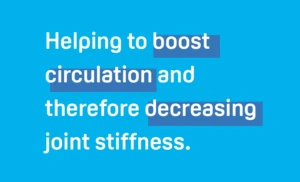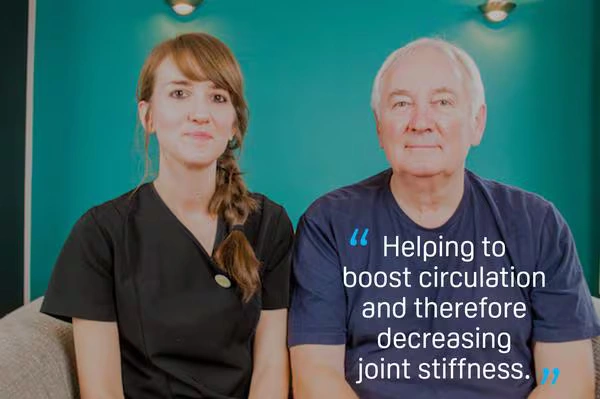Last week we spoke to massage therapist Jo of Massage And Me about the benefits massage can have for those with painful or arthritic joints. Having someone pamper you can be a luxury but here Jo shares, with the help of Pete Murch who has mild arthritis, some of tips for simple massages you can perform on yourself.
Some people will find they are not able to perform all or any of these therapies so please only undertake what your joints can withstand. As Jo says “massage should never be painful” so if any of these cause you pain then STOP. If you are in any doubt please consult your doctor before embarking on these therapies.
Knee Massage
It is important to warm the muscles up before starting to massage. Do this by laying your hands flat against the skin and moving in circular movements. We must do this before using firmer pressure to ensure the muscles are ready – just as athletes would warm up before strenuous exercise.

1) Warm all areas of the knee. Remember that by massaging the muscles surrounding the arthritic joints we are helping to boost circulation and therefore decreasing joint stiffness.
2) As the knee is such a sensitive joint, it is important to build up the pressure gradually. Whilst doing the circular movement warm-ups, try to increase your pressure slowly, using the tips of your fingers to get into those troublesome areas.
3) Try to move all the muscles around the knee area, very carefully and slowly. By manipulating the whole knee in this way we can really improve circulation and range of motion, especially with clients who have trouble walking and exercising.
Knee Massage Two
If you find an area of tension, or an area where the arthritis is painful, see if you can handle some increased pressure. This is most effectively done with the heel of your hand as shown here. The surface area is larger than our fingers, yet the pressure can be firmer and more effective with arthritis pain. It also saves your fingers, which can be most welcome if you have arthritis in your hands/fingers.

1) Use the heel of your hand to go in circular motions around your knee joint. As with all massage techniques, always work upwards, starting at the base of your knee and moving upwards, towards your heart.
2) As well as moving in circular movements, you can also do sliding movements upwards, making sure that you are always comfortable with the pressure.
3) By now, your muscles should be nicely warmed. This is the perfect time to try to increase the pressure, to moderate. Try to feel where your arthritis is most painful and, if possible, focus on these areas. Some people may refer to these areas as the ‘crackly bits’ of the arthritic joint. Use your fingertips to try and gently press down here, again in circular motions.
Remember to use your moderate pressure in muscles all around the knee, stretching out to the sides as well.
4) As pain in the knee can also affect us on the underside, it is important to remember massage underneath the knee too. When doing this, ensure you support the knee fully, using both hands. Your massage technique should be similar to the one already used on the knee socket area but just reversing your strokes to focus on the underside.
5) By using your fingers, stretch the skin on the underside of your knee. This area of the knee often gets neglected, but can really have a large impact, as it works so hard to support the front of the knee.
Neck Massage
After warming up the neck muscles use your fingertips to exert light pressure on your neck. This helps us to feel where our more sensitive spots are. The benefit of self-massage is that you can tell yourself where the sensitive areas are and adjust your pressure accordingly. Remember we should never experience pain through massage.
A lot of people hold tension at the back of their neck or in the muscles between their ears and the back of the neck. It is a good idea to explore this area first with your fingertips.

1) Once you have ascertained where your tension areas are, use the heel of your hand to exert moderate pressure on the problem areas. Massage in circular movements, ensuring you are stretching your head away to feel the stretch whilst you are massaging.
2) To end, use your whole hand to warm the whole neck area and allow your muscles to recover. Another great way to warm up your muscles pre-massage, and retain heat in your muscles post-massage, is to either use a hot water bottle with a towel over it so as to avoid burning, or use a heated (and scented if you wish) rice bag which you can put in the microwave and place over the skin.
Neck Massage Two
This might look rather unnatural, but neck stretches can be a great way of bringing relief and easing tension to the neck area, especially as it is harder to reach ourselves than areas such as the knee.

1) Using one hand to pull your head, and the other to push your shoulder down, imagine you are pulling your head away from your shoulder; you want them to be as far apart as possible, but once again without causing any discomfort or pain.
2) Easing tension in our necks can also help to ease the strain in our backs. Just remember to stretch your head only from side to side, never backward as this puts unwanted strain on your spinal cord.
Hip Massage
Our hips can sometimes take a little more pressure than more fragile areas such as our necks, so we will use the heel of hand to build up to a more moderate pressure.

1) Moving in an upwards direction towards the heart, using circular motions, we are aiming to massage all around the hip joint. Osteoarthritis in the hip can be particularly debilitating and hinder movement. By massaging around the joint, we can help boost circulation to the muscles supporting it.
Hip Joint Rotation
This movement is used as a warm-up exercise during some deep tissue or sports massages. As we are supporting the joint here, thankfully it is low impact.

1) With this stretch, make sure you always support your leg fully. Try to relax your leg, do not strain it.
2) Your range of motion should be to lift up the leg, move it outwards away from your other leg (do not strain; stop if painful).
3) Move downwards and finally in until you start again. Try to do five one way and then five in the opposite direction.
Foot Massage
It can be difficult for us all to reach our feet, so it is a good idea to use props to do the hard work for us. This is called a plantar fascia stretch and is easily done with a tin of beans, sweetcorn, sauce etc. This can be done standing up, but it is much safer to do sitting down.

1) Roll the tin in all directions, both backwards and forwards and also left to right. Try to go slow and steadily, and focus on problem areas as you feel them. Do not exert so much pressure that you are in pain.
2) Make sure you roll the tin all the way to the toes, pushing down on the balls of your feet. Often our feet get neglected with care plans, but self-massage here can be extremely beneficial. This can be done twice a day, performed for a few minutes if possible.
Hand Massage
For those of us who feel the need for a finger/hand massage it can be very difficult to do ourselves. Therefore, it is a good idea to use a prop to help save any further strain on our hands. A cork is a great pop to use, as it is small and easy to handle but can also help us to build up pressure, saving our vulnerable thumbs from having to do any more work.

1) Having warmed up your hands, hold a cork with one hand, stretch the palm of your other hand. Then use the cork to exert moderate pressure on the palm. It is a good idea to go down the lines of your fingers as well as doing circular motions on the palm.
2) It is important to reach all areas of our hands, including the tiny muscles between thumb and forefinger. Our hands work so hard it is important to give all the areas a break with this move. This is particularly good if you have any arthritic fluid in your thumb.
Arm Massage
Whilst still using the cork we can also help to ease pressure on our arms. No matter what age many of us hold tension in our arms. You can even feel the congestion and release of pressure whilst doing this movement.

1) Using the cork, exert moderate pressure and work in straight lines between the wrist and the elbow. This helps to clear congestion, tension, and ease the strain on our wrists and hands, which can be severely affected by arthritis.
Finger Massage
Many feel arthritis in fingers, especially around the knuckles. This can be a highly sensitive area, so make sure you never hurt yourselves. These finger pulls can help to ease tension.

1) With your opposite hand, do circular motions down your finger, exerting pressure around problem areas such as your knuckles.
You can do this on each finger, but remember not to pull your thumbs.
You can find out more about Jo and Massage And Me on her WEBSITE as well as following her on Facebook.




